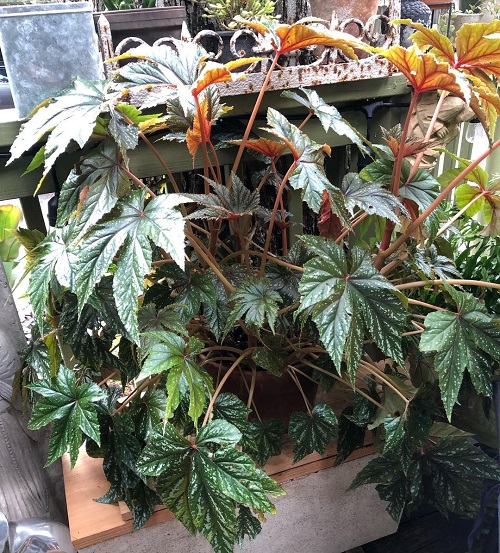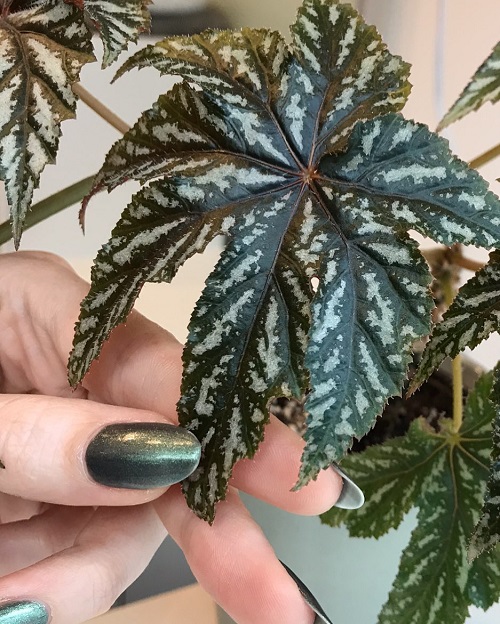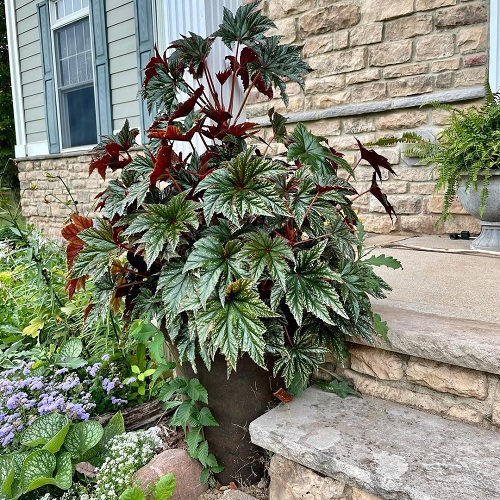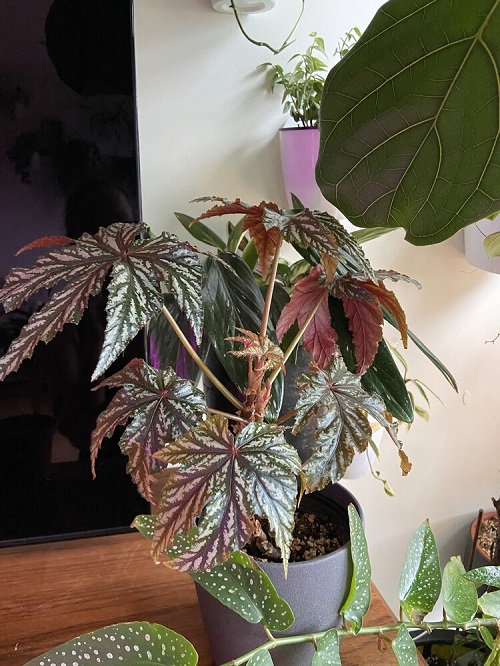Discover all secret tips and tricks for shining foliage with our insightful Gryphon Begonia Care and Growing Guide.
With our Gryphon Begonia Care and Growing Guide, you’ll learn essential tips and techniques to ensure vibrant foliage and flourishing blooms. From ideal lighting conditions to watering strategies, this guide has everything you need to cultivate a thriving Gryphon Begonia collection.
Botanical Name: Begonia x hybrida ‘Gryphon’
USDA Zones: 8 – 10
Read a detailed article on Elatior Begonia Care and Growing Guide
Gryphon Begonia Plant Information
The Gryphon Begonia (Begonia griffithiana) is a hybrid begonia cultivar native to the Himalayan mountains of northeast India and Bhutan. It is a semi-succulent, rhizomatous perennial known for its unique foliage. The leaves can grow up to 10 inches long and have swirling shades of green, silver, purple, and red. Some varieties have heavily ruffled or spiraled leaves adding to their fantastical appearance.
Gryphon begonias produce small pinkish-white flowers, but they are primarily grown for their highly ornamental and sculptural foliage. These begonias require bright, filtered light and well-draining soil to thrive indoors as houseplants or in shaded outdoor gardens.
Check out Begonia Maculata Care and Growing Guide in this article
Propagating Gryphon Begonia

You can easily propagate new Gryphon Begonia using stem cuttings.
Materials You Need:
- Sharp pruners or scissors
- Small pots or containers
- Potting mix
- Rooting hormone powder (optional)
Steps:
1. Take cuttings from healthy gryphon begonia plants using clean scissors or pruners. Choose stems that are 4-6 inches long and make a cut just below a node (the point where leaves emerge).
2. Remove the lower leaves from the cuttings, leaving 2-3 leaves at the top.
3. If using rooting hormone powder, dip the cut end of each stem in the powder so that a light coating sticks to it. This helps the cuttings to grow roots easily and more quickly.
4. Fill small pots or containers with moistened potting mix. Poke holes in the mix and carefully insert the cuttings into the holes, firming the mix around them. Space multiple cuttings a few inches apart.
5. Water the potting mix until moist but not waterlogged. Cover the pots with plastic bags or domes to create a humid environment.
6. Place the covered pots in a warm, bright location out of direct sun.
7. Check every few days and water when the mix starts to dry out.
8. After 4-6 weeks, tug gently on the cuttings. If you feel resistance, it means that new roots have formed. Carefully transplant well-rooted cuttings into larger pots with fresh potting mix.
Best Pot Size for Gryphon Begonia
For small or young Gryphon Begonia plants, a pot with a width of 6-8 inches is usually good enough for a couple of years. Based on how much the plant grows and spreads, you can move it to a container one size bigger than the old one.
Requirements for Growing Gryphon Begonia
Sunlight
Gryphon Begonias grow best in bright but indirect sunlight. They prefer a location that receives filtered sunlight or partial shade. Avoid placing them in direct sunlight as it can burn their delicate leaves.
Indoor locations near east or west-facing windows, where they can receive bright but indirect light, are generally ideal for Gryphon Begonias.
Soil
Gryphon Begonias prefers a well-draining growing mix that retains some moisture without becoming waterlogged. You should use a blend of peat moss, perlite, and well-decomposed organic matter in equal parts.
This type of soil provides adequate drainage while retaining the necessary moisture for the plant’s roots.
Water
Proper watering is key for growing healthy Gryphon Begonias. They prefer moist soil but not soggy conditions. Let the top inch of soil dry out a bit between waterings, then water the plant thoroughly until water drains from the bottom of the pot.
Avoid overwatering, as it can cause root rot. Adjust the watering schedule based on the environment and season, keeping the soil consistently moist but not too wet.
Temperature & Humidity
Gryphon Begonias thrive in warm temperatures ranging from 65 to 85°F (18°C to 28°C). They are sensitive to cold drafts and temperature fluctuations, so it’s important to keep them away from cold windows or areas with significant temperature variations.
It likes moderate to high humidity levels. If the air is dry, use a humidifier, place a water tray near the plant, or mist the leaves regularly to increase humidity around the plant.
Gryphon Begonia Care

Fertilizer
Gryphon Begonias benefits from regular fertilization to support healthy growth and vibrant foliage. Use a balanced, water-soluble fertilizer with a ratio of 20-20-20 or a specific fertilizer formulated for begonias.
During the active growing season, typically spring and summer, dilute the fertilizer according to the package instructions and apply it every 5-7 weeks. Refrain fertilization during the dormant period in fall and winter.
Pruning
Pruning Gryphon Begonias is not usually necessary for maintenance, but it can help shape the plant and make it look fuller.
Remove any leaves that have turned yellow or got damaged to keep the plant look neat. If the plant starts to look leggy or stretched out, you can cut back the stems to encourgae more branching.
You can prune the plant any time of the year as needed, using clean and sharp pruning shears to make smooth cuts.
Pests and Diseases
Gryphon Begonias are generally resistant to pests and diseases, but they can sometimes encounter issues. Common pests that may affect Them include mealybugs, aphids, and spider mites.
Check the plant regularly for signs of pests like bugs, sticky leaves, or distorted leaves, and treat them with appropriate organic or chemical insecticides if needed.
To prevent fungal diseases like powdery mildew or root rot, ensure the plant has good airflow and does not overwater.




